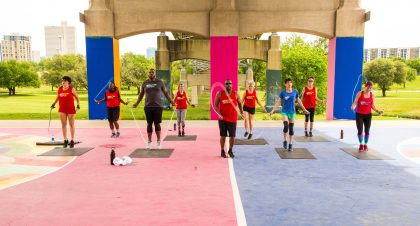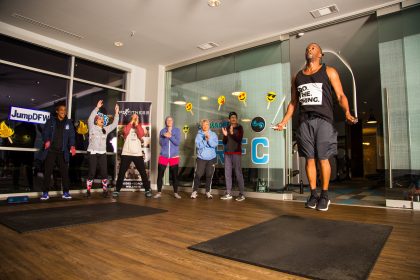24 Hours of Jumping…for Kids
In April 2019, a group of 16 jump rope fitness enthusiasts in Texas came together to do a 24-hour jump-a-thon that raised over $2,700 for Action for Healthy Kids, and we could not be more grateful…or impressed. Since that’s a pretty intense event, we wanted to find out what motivated them. We spoke to organizers Steve Gaspard, Adrienne Kramer, and Melissa Fargo Lewis.
 Q: How did you all come to the decision to do a charity jump-a-thon?
Q: How did you all come to the decision to do a charity jump-a-thon?
Steve: It started with the idea of doing something that would be challenging and beneficial to everyone. Being that there are so many charity events that have been done before, I wanted to really go out of the box. So that is how I came up with the 24-hour jump-a-thon.
Melissa: He came up with the idea last summer, after having done a couple of one-hour jumps. From there, he approached Crossrope about sponsoring it and already knew that we would do it to support a charity. I liked the idea immediately and was in on some of the initial brainstorming for it. Once it all started to come together, I was already excited about being able to not only train for something like this, but also to do it to raise money for a great charity.
Adrienne: I offered to help with the choosing of a charity, the organization of the event and the training plan. Steve secured a location and members of the team. It then took on a life of its own!
Q: What was the hardest part of preparing for it?
Steve: The hardest part of preparing was our unknown readiness for the 2nd jump—for most of us that was during the twilight and early hours of the morning with little to no sleep. We all jumped at a certain time and then again 11 hours later, but practicing in your own setting under your own circumstances is different than the actual showtime.
Melissa: The beginning of training in 2018 was the hardest part. Most of the training I do is timed segments, like 30 seconds, 45, or maybe 1 minute. I do multiple rounds of this for anywhere from 20 minutes to 40 minutes total for the whole workout. So to start jumping non-stop was hard at the beginning. Not necessarily physically, but from a psychological standpoint. Just wrapping your head around it and finding a way to let yourself “disappear” in your music or try to solve all your problems while doing the jump.
Adrienne: The workouts were a mental challenge first and then a physical challenge. Thinking about jumping for an hour seemed daunting, and turning off my brain so that I could do it was almost more of a challenge than doing it.
Q: What was the biggest challenge during the event?
Melissa: Definitely the lack of sleep and really nowhere to get really comfortable between the times I was jumping. I had very little sleep the three nights prior to the event, just due to excitement and being in a strange bed. So the tiredness and being at the studio for 24 hours straight took a toll on my body. But even with that, I never wavered in my one hour jump slots or in the relays I jumped in throughout the day and night.
Adrienne: As a whole, the event went relatively smoothly. There were some brief moments of figuring out how to fill in for people but these were minor issues. The second hour of jumping took some digging deep to get through but there was so much support that wasn’t too bad.
 Q: How did you feel afterward?
Q: How did you feel afterward?
Steve: I felt like I ran two marathons back-to-back. I didn’t get my legs back until three days later. I couldn’t work out until four days later.
Melissa: I felt kind of like I had run a marathon, sat down for a minute or so, and then ran another one! Funny thing though, we all got showered and cleaned up and met for breakfast two hours later, and I was already feeling pretty awesome. Part of that was living on the adrenaline of having completed the event. Later that day, the fatigue definitely set in. Personally, it took me until maybe Thursday of that week to completely recover from the entire event.
Adrienne: I was a little bit sore, but the lack of sleep was the harder part to get over. We didn’t get into a bed until about 44 hours after we got up Saturday morning. I was jumping again by Wednesday but it took a couple of weeks to feel caught up on sleep.
Q: What is your favorite thing about jumping rope?
Steve: The benefits you can get in as little as 30 minutes or, if you are adventurous, going for a hour or more. Then the long term effects are especially amazing.
Melissa: Hard to define my favorite thing about jumping rope, but I guess it starts with the joy I get out of the great workout I get from it. It is also a great source of stress relief for me. Using the weighted ropes to get a total workout challenges my cardio and works my upper and lower body.
Adrienne: There are so many things you can do with jump ropes. It is truly a fun way to get exercise and build endurance without it feeling like a chore.
Q: What got you into jumping rope in the first place?
Steve: I used to run a lot, and the only problem with running is that it took you away from home for hours at a time. I wanted to find something just as beneficial, if not more, that was as cost-effective as running. After jumping casually, I began seeing change, and from there I went all in and haven’t looked back.
Melissa: I got started with jumping rope about eight years ago when I was without a club membership for the first time in many years. I had been a certified personal trainer before my oldest son was born, so I had the experience to know how to put together workouts but was still at a bit of a loss. I realized that I didn’t need all the fancy gym equipment to get a really great workout. I got an inexpensive speed rope for some variety. I quickly realized that it provided a great cardio workout, so I incorporated it into my workouts. I started using the weighted ropes from Crossrope in July 2017 and was immediately hooked on them. They took the jumping rope to a whole new height!
Adrienne: I had a knee surgery, and it was a surprisingly good way to transition from walking to higher impact activities like running.
Q: Why did you choose to support Action for Healthy Kids?
Steve: We began searching for charities and knew we wanted something dealing with children’s health. AFHK popped up in our initial research, and we knew this was the one to work with. After our first call, we made it happen.
Melissa: Adrienne was the one who did the research on charities and found Action for Healthy Kids, but Steve and I knew we wanted to support one that was about promoting good health. AFHK just fit so well with all of us since we are all passionate about getting all ages interested in jumping rope and adopting a healthy diet and active lifestyle.
Adrienne: We were looking for an organization that was nationwide and supportive of health and wellness. When we found AFHK and read the goals and mission, it felt like a perfect fit.
Q: To you, what does it mean for a child to be healthy?
Steve: Supporting child health can change a whole generation to come. Children are staying indoors more frequently, and while it may not have a huge effect now, as children get older, unhealthy habits form. Those children become adults, and now all that time spent not being active can leads to health issues that could’ve been prevented with activity throughout childhood.
Melissa: For me, a child being healthy means more than just something basic like whether they are at a healthy weight for their size and age. It is about encouraging and teaching them to be active, eat healthy foods and understand why that is so important now and as an adult. Being healthy is about their whole body, physical, emotional, and psychological. Having two teenagers, I see the stresses kids are under these days, and they seem to have more of it than I did in their days. I think eating healthy and being active not only helps them maintain a healthy weight, but also helps them to work through the stress and decisions they are faced with as teenagers.
Adrienne: For a child to be healthy, it is not just a reflection of physical health but also emotional. Ample nutritious food and plenty of activity is a good start, but they also need to feel loved and supported.
Categories: Team Healthy Kids, Texas
 Q: How did you all come to the decision to do a charity jump-a-thon?
Q: How did you all come to the decision to do a charity jump-a-thon? Q: How did you feel afterward?
Q: How did you feel afterward?